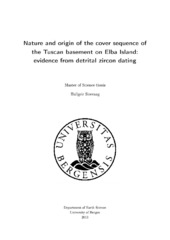| dc.description.abstract | Elba Island represents the westernmost part of the northern Apennines and has, for the last decades, been a subject to comprehensive geological studies. Due to west-directed subduction of the Adriatic microplate below Corsica-Sardinia since late Cretaceous times, resulting in piling-up of Tuscan-, Ligurian- and Ligurian-Piedmontese units, and the late Eocene-early Miocene thrusting of the Ligurian accretionary wedge onto the Tuscan margin, it is di cult to determine the origin of the metasedimentary rocks on Elba. Still, most of the age relationships of the metasedimentary rocks on Elba are based fossil content or on correlation of similar rocks in mainland Tuscany, Corsica and Sardinia. Because very little information is available about the provenance of the cover sequence of the Tuscan basement on Elba, this study aims at providing more accurate age relationships for selected lithologies within the Ortano, Acquadolce and Monticiano-Roccastrada units on eastern Elba, as well as trying to trace the origin of the sediments. Detrital zircons from six samples from eastern Elba have been U/Pb dated. The LA-ICPMS technique has been applied in order to analyse a large quantity of zircons. This is the rst study to provide U/Pb zircon crystallization ages for the unimodal populations or subpopulations within the quartzo-phyllitic Capo d'Arco Schists (Ortano Unit) and the phyllites and metasiltstones (Acquadolce Unit), respectively. New constraints on the maximum age of deposition is provided for most of the selected lithologies. Maximum deposition ages of Lower Devonian and uppermost Silurian times are suggested for the Capo d'Arco Schists and the blackish quartzites and phyllites, respectively. A crystallization age for the igneous source rock of the quartzo-phyllitic Capo d'Arco Schist is calculated to 422±8 Ma. Analyses of the phyllites and metasiltstones provide controversial, yet very interesting results. The phyllites and metasiltstones, which previously have been attributed to the upper part of the Lower Cretaceous, contains a subpopulation of young, idiomorphic detrital zircons. These form a tight unimodal population with an age of 32±1 Ma. This is interpreted to represent the crystallization of an igneous source rock and is used to establish a maximum age of deposition of late Eocene-early Oligocene age. The previously suggested late Carboniferous-early Permian age of the Rio Marina Formation and the Middle-Upper Triassic age of the Verruca Formation is still be regarded as reasonable, on the basis of U/Pb dating from the present study. The U/Pb data from the present study provide further evidences for an African a nity of the metasediments. It is suggested that the majority of the zircons in the present study can be interpreted as being erosional products from the African continent, the Iberian Massif and from the late Eocene-middle Miocene igneous phase on Sardinia. | en_US |
